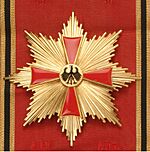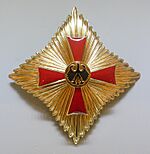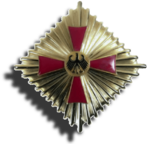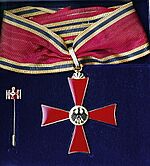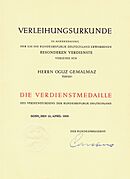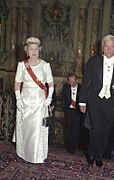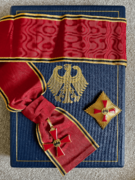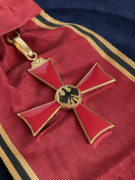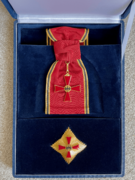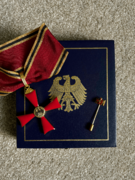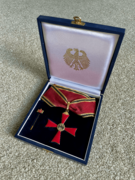Order of Merit of the Federal Republic of Germany facts for kids
Quick facts for kids Order of Merit of theFederal Republic of Germany |
|
|---|---|
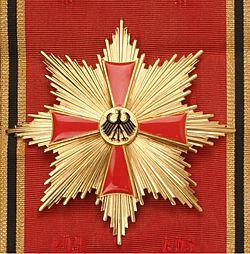
Special Class of the Grand Cross
(reserved for heads of state) |
|
| Country | Federal Republic of Germany |
| Type | Order of merit with one special and eight regular classes |
| Eligibility | Civilian and military personnel |
| Statistics | |
| Established | 7 September 1951 |
Grand Cross Special Class
Medal Ribbon bars of the Order of Merit |
|
The Order of Merit of the Federal Republic of Germany (German: Verdienstorden der Bundesrepublik Deutschland) is Germany's highest award. It can be given to people for achievements in any area of work. The first President of Germany, Theodor Heuss, created this award on September 7, 1951. People often call the different levels of this award the Federal Cross of Merit (Bundesverdienstkreuz).
More than 262,000 people, both Germans and foreigners, have received this award. The number of awards given each year has changed over time. Since 2013, about 30–35% of the people who receive the award have been women.
Most German states have their own awards. However, the cities of Bremen and Hamburg do not give out such awards. This is a long-standing tradition. Citizens from these cities, especially former leaders, often refuse any awards. A famous example is former Chancellor Helmut Schmidt.
Contents
History of the Order of Merit
The Order of Merit was started on September 7, 1951. It was created by a special order from Federal President Theodor Heuss. This order was also signed by German Chancellor Konrad Adenauer and Minister of the Interior Robert Lehr.
The order said that the award was meant to "visibly express recognition and gratitude to deserving men and women." It was for people who helped rebuild Germany after the war. This included work in politics, economy, and education. The award was for anyone whose efforts helped Germany grow peacefully.
In 2022, Federal President Frank-Walter Steinmeier introduced a new rule. This rule states that at least 40% of the people nominated for the award must be women.
Classes of the Order of Merit
The Order of Merit has four main groups. These groups include eight regular levels and one special medal level. Here are the levels, from highest to lowest:
- Grand Cross (German: Großkreuz)
- Grand Cross special class (Sonderstufe des Großkreuzes): This is the highest level. It is usually given to the President of Germany and to foreign head of states and their spouses.
- Grand Cross 1st class in exceptional finish (Großkreuz in besonderer Ausführung): This special version is for former Federal Chancellors of Germany. Only three people have received it: Konrad Adenauer, Helmut Kohl, and Angela Merkel.
- Grand Cross 1st class (Großkreuz)
- Great Cross of Merit (Großes Verdienstkreuz)
- Great Cross of Merit with Star and Sash (Großes Verdienstkreuz mit Stern und Schulterband)
- Great Cross of Merit with Star (Großes Verdienstkreuz mit Stern)
- Great Cross of Merit (Großes Verdienstkreuz)
- Cross of Merit (Verdienstkreuz)
- Officer's Cross of the Order of Merit (Verdienstkreuz 1. Klasse)
- Cross of the Order of Merit (Verdienstkreuz am Bande)
- Medal of Merit (Verdienstmedaille)
- Medal of the Order of Merit (Verdienstmedaille): This is the lowest level of the award.
The President of Germany automatically holds the Grand Cross special class. This is given to them in a ceremony. Other than the German president, only foreign leaders and their spouses can receive this highest award.
What the Award Looks Like
The main part of the award, called the "badge," looks similar for most levels. It has a golden four-armed cross with red enamel. In the middle, there is a gold disc with a black German federal eagle (Bundesadler) on it. The badge is slightly smaller for women.
For the lowest levels (Member and Officer), the badge is only enameled on one side and flat on the back.
Many levels of the award also include a "star." This is a golden star with straight rays. The size and number of points on the star change depending on the award level. The badge is placed on top of the star.
The riband (ribbon) of the Order uses the colors of the German flag. It has a large red band in the middle, with smaller gold-black-gold stripes on each side.
Gallery
-
Foreign head of state Queen Elizabeth II with the Grand Cross special class, 1992 visit in Brühl (Rhineland), Germany -
The gold foil German Bundesadler found on the inner lid of the Order
Recipients
See also
 In Spanish: Orden del Mérito de la República Federal de Alemania para niños
In Spanish: Orden del Mérito de la República Federal de Alemania para niños
- Iron Cross
- Order of Karl Marx
- Pour le Mérite
- Knight's Cross of the Iron Cross
- Awards and decorations of the German Armed Forces



